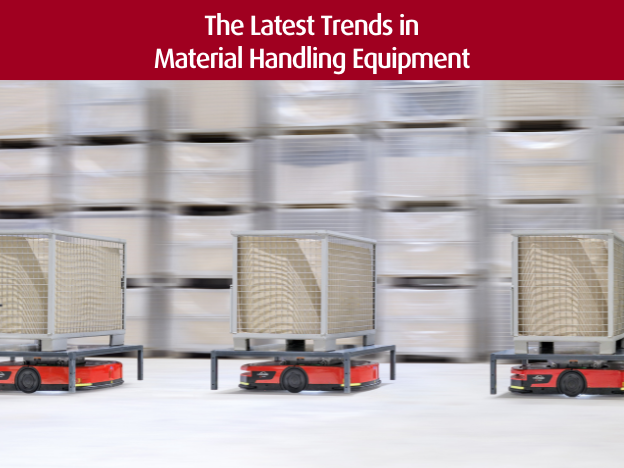As industries evolve, so does the need for innovative solutions in material handling equipment. Efficient logistics and seamless operations are essential to maintaining competitive advantages in manufacturing, warehousing, and supply chain management. With constant advancements in technology, the material handling sector is experiencing a transformative period with some new trends and advancements, enabling businesses to optimize processes, enhance safety, and reduce operational costs.
Some of these trends are here to stay and it’s important for companies to embrace them in order to gain competitive advantage. Here we have compiled some of those latest trends in material handling equipment that are shaping the industry today for good.
1. Sustainability and Eco-Friendly Solutions
Sustainability is no longer a buzzword—it’s a critical component of operational strategies. The material handling industry has seen a sharp rise in demand for energy-efficient equipment, particularly electric-powered forklifts. Lithium-ion forklifts, in particular, are gaining significant traction.
There is a need in the material handling industry for eco-friendly innovation. This can be done by using new-age eco-friendly forklifts. For example, Linde’s forklifts produce zero emissions and operate quietly, making them a great eco-friendly option. Additionally, Linde offers lithium-ion batteries, which provide longer operating hours, faster charging, and lower maintenance costs compared to traditional lead-acid batteries. This allows businesses to reduce both their environmental impact and their energy expenses.
Why this matters:
As governments and consumers push for greater sustainability, businesses are under pressure to adopt greener practices. Investing in energy-efficient material handling equipment not only supports environmental goals but can also lead to long-term cost savings.
2. Automation and Robotics Integration
Automation is undoubtedly one of the most significant trends reshaping material handling. The electrification of material handling equipment (MHE) is leading the transition from conventional fuel-powered machines to electric battery-operated alternatives, providing cleaner and more efficient solutions. This shift is evident in automated guided vehicles (AGVs), autonomous mobile robots (AMRs), and other robotic systems, which are increasingly being integrated into electric MHE.
To make the best use of this trend, companies need to integrate automation into their forklifts and warehouse equipment to improve efficiency and precision. Automated forklifts by Linde, for example, can operate continuously, enhancing productivity while reducing downtime. They can also communicate with warehouse management systems (WMS) to navigate routes efficiently and handle tasks autonomously. This technology reduces human error and labor costs while ensuring smoother, more reliable operations.
Why this matters:
Automating material handling processes leads to increased efficiency and reduced reliance on human labor. As businesses look to scale operations and meet growing demands, automation provides a path to faster, safer, and more consistent material flow.
3. Data-Driven Operations and IoT Integration
The Internet of Things (IoT) and data analytics are revolutionizing how material handling operations are managed. Through connected devices and sensors, warehouse managers can gather real-time data on equipment usage, performance, and maintenance needs. This data allows for predictive maintenance, optimized workflows, and more informed decision-making.
Linde has integrated IoT technology into the forklifts through our innovative Linde Service Monitoring System (SMS). This system provides real-time monitoring of engine hours, idle time, and other critical metrics, helping operators avoid breakdowns and optimize total cost of ownership. Predictive maintenance can be scheduled based on actual usage, ensuring that equipment stays in top condition while minimizing unnecessary downtime.
Why this matters:
Data-driven insights can significantly improve operational efficiency. With IoT integration, businesses can streamline processes, reduce maintenance costs, and ensure optimal equipment performance
4. Enhanced Safety Features
Safety is a top priority in material handling environments, where heavy machinery operates in close proximity to personnel. Advanced safety features in modern MHE aim to reduce workplace accidents and improve overall operational security.
Nowadays, every company is trying to incorporate state-of-the-art safety technologies across its range of forklifts and warehouse equipment. Using forklifts that are equipped with features such as Load Control and ergonomic cabins, which enhance operator comfort and control can go a long way. Linde offers all these features of the material handling vehicles along with comprehensive safety systems like 360-degree visibility, load stability sensors, and emergency braking capabilities to prevent accidents.
Why this matters:
Injury prevention not only safeguards employees but also prevents costly disruptions to operations. The latest advancements in safety technology provide peace of mind for employers, while also boosting operational efficiency.
5. Ergonomics and Operator Comfort
In today’s material handling industry, there is growing recognition of the importance of ergonomics. Forklift operators spend long hours on the job, and discomfort can lead to reduced productivity, injuries, and fatigue. As a result, manufacturers are focusing on designing operator cabins and controls that prioritize user comfort and minimize strain.
Experts recommend using forklifts that are integrated ergonomically designed operator cabins. For example, Linde’s forklifts with features like adjustable seats, intuitive control systems, and climate control ensure that operators can work comfortably, even during extended shifts. This focus on ergonomics not only improves operator well-being but also boosts efficiency by reducing fatigue and enhancing concentration.
Why this matters:
Improving ergonomics can lead to a more satisfied, healthier workforce, which translates to higher productivity and fewer workplace injuries.
Conclusion
The material handling industry is undergoing significant changes, driven by technological advancements, a push for sustainability, and a focus on safety and efficiency. At Linde Material Handling, we are at the forefront of these trends, offering cutting-edge solutions designed to enhance the efficiency, performance, and safety of your operations. Whether you’re investing in automation, embracing eco-friendly equipment, or seeking data-driven insights, our wide range of products can help you meet the challenges of modern logistics.
Invest in Linde’s diesel forklifts today and elevate your lifting capabilities to new heights. Contact us at 1800 270 1123 or visit www.lindemhe.com for more details.
